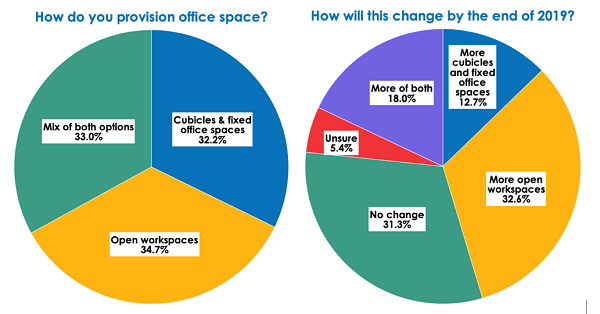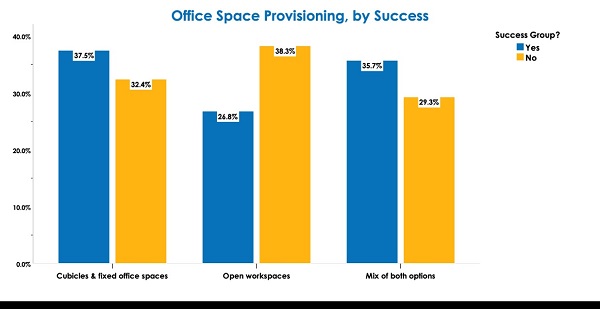Open workspaces have become the de-facto standard in workspace design. According to the Society of Human Relations Management,
roughly 70% of offices have at least some open workspace design. In our own 2019 global study of approximately 635 end-user organizations, Nemertes Research found that 34.7% of participants only provision open workspaces – a leap from 16.7% in 2018. An additional 33% provision a mix of open and fixed workspaces, while nearly as many, 32.6%, planned to add more open workspaces by the end of 2019. Just 12.7% planned to increase only fixed workspaces.
In the last few years open offices have come under fire from researchers and, more importantly, those who work in them. It seems that cramming a large number of a people into a small area, without privacy, doesn’t exactly do wonders for productivity. Meanwhile organizations continue to increase their use of open workspaces, often driven by the opportunity to reduce real estate costs, and to better support teleworkers who may only need temporary or occasional in-office workspaces.
Nemertes’ study found that the use of open workspaces negatively correlates with collaboration’s success. Our success model is based on identifying quantifiable benefits from collaboration investments such as cost savings, revenue gains, or measured productivity improvements. We then created a success group that included those companies that had achieved higher than average benefits in one or more of these areas. Of those using open workspaces, just 26.8% were in our success group, compared to 37.5% of those using cubicles and fixed office spaces. This means that open workspaces are negatively impacting collaboration investment ROI!
Aside from concerns related to background noise, interruptions, and lack of privacy, open workspaces have been found to have some unexpected impacts on worker collaboration. For example, a 2018 Harvard University
study ironically found that workers in open offices tend to communicate less face-to-face, and instead send more email and messages. This counterintuitive finding highlighted that in open workspaces workers are reluctant to interrupt each other, even if they’re sitting in the same open area. Another study, cited in the same article, found that open workspaces tend to lead to worse interpersonal relationships among co-workers than fixed workspaces or telework programs.
Unfortunately, it doesn’t seem yet that those responsible for facilities design are moving yet to reduce or eliminate open offices. Given that, IT, real estate/facilities, and HR leaders must develop strategies and embrace technologies that can offer at least some opportunities for effective work and collaboration within open workspace environments. Examples include:
- Provisioning noise cancellation headphones to limit distractions from background noise
- Adopting team collaboration applications that support growing message volumes by enabling collaboration in the context of teams and projects
- Using screen privacy filters to limit the tendency of workers to peek at the displays of others
- Providing huddle spaces, especially enclosed ones, to allow workers to work privately in peace and quiet, meet in small groups when necessary, or engage in meetings (ideally video-enabled) without distracting others
- Supporting telework to allow employees to work from wherever they’re most comfortable
- Providing a feedback mechanism to understand employee attitudes and concerns about their workspaces
- Using office design elements like white noise and aesthetic elements such as plants, lighting, and even fish tanks to improve the aura of open offices
- Installation of noise cancellation and absorption materials as well as privacy screens
The reality is that despite the negative correlations with using open offices, open office designs are likely here to stay. IT, HR, and real estate/facilities teams must work together to improve open office designs as much as possible, and to provide workspaces and technologies that can potentially contribute to improving worker collaboration, productivity, and happiness.








